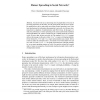Free Online Productivity Tools
i2Speak
i2Symbol
i2OCR
iTex2Img
iWeb2Print
iWeb2Shot
i2Type
iPdf2Split
iPdf2Merge
i2Bopomofo
i2Arabic
i2Style
i2Image
i2PDF
iLatex2Rtf
Sci2ools
ICALP
2009
Springer
2009
Springer
Rumor Spreading in Social Networks
Social networks are an interesting class of graphs likely to become of increasing importance in the future, not only theoretically, but also for its probable applications to ad hoc and mobile networking. Rumor spreading is one of the basic mechanisms for information dissemination in networks, its relevance stemming from its simplicity of implementation and effectiveness. In this paper, we study the performance of rumor spreading in the classic preferential attachment model of Bollob?as et al. which is considered to be a valuable model for social networks. We prove that, in these networks: (a) The standard PUSH-PULL strategy delivers the message to all nodes within O(log2 n) rounds with high probability; (b) by themselves, PUSH and PULL require polynomially many rounds. (These results are under the assumption that m, the number of new links added with each new node is at least 2. If m = 1 the graph is disconnected with high probability, so no rumor spreading strategy can work.) Our anal...
ICALP 2009 | Preferential Attachment Graphs | Rumor Spreading | Rumor Spreading Strategy | Theoretical Computer Science |
| Added | 03 Dec 2009 |
| Updated | 03 Dec 2009 |
| Type | Conference |
| Year | 2009 |
| Where | ICALP |
| Authors | Flavio Chierichetti, Silvio Lattanzi, Alessandro Panconesi |
Comments (0)

